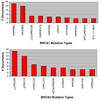BRCA1 and BRCA2 mutation carriers in the Breast Cancer Family Registry: an open resource for collaborative research
- PMID: 18704680
- PMCID: PMC2775077
- DOI: 10.1007/s10549-008-0153-8
BRCA1 and BRCA2 mutation carriers in the Breast Cancer Family Registry: an open resource for collaborative research
Abstract
The Breast Cancer Family Registry is a resource for interdisciplinary and translational studies of the genetic epidemiology of breast cancer. This resource is available to researchers worldwide for collaborative studies. Herein, we report the results of testing for germline mutations in BRCA1 and BRCA2. We have tested 4,531 probands for mutations in BRCA1 and 4,084 in BRCA2. Deleterious mutations in BRCA1 and BRCA2 were identified for 9.8% of probands tested [233/4,531 (5.1%) for BRCA1 and 193/4,084 (4.7%) for BRCA2]. Of 1,385 Ashkenazi Jewish women tested for only the three founder mutations, 17.4% carried a deleterious mutation. In total, from the proband and subsequent family testing, 1,360 female mutation carriers (788 in BRCA1, 566 in BRCA2, 6 in both BRCA1 and BRCA2) have been identified. The value of the resource has been greatly enhanced by determining the germline BRCA1 and BRCA2 mutation statuses of nearly 6,000 probands.
Figures
Similar articles
-
Genetic Predisposition to Breast Cancer Due to Mutations Other Than BRCA1 and BRCA2 Founder Alleles Among Ashkenazi Jewish Women.JAMA Oncol. 2017 Dec 1;3(12):1647-1653. doi: 10.1001/jamaoncol.2017.1996. JAMA Oncol. 2017. PMID: 28727877 Free PMC article.
-
Prevalence of BRCA1 and BRCA2 mutations in Ashkenazi Jewish families with breast and pancreatic cancer.Cancer. 2012 Jan 15;118(2):493-9. doi: 10.1002/cncr.26191. Epub 2011 May 19. Cancer. 2012. PMID: 21598239
-
Double heterozygosity in the BRCA1 and BRCA2 genes in the Jewish population.Ann Oncol. 2011 Apr;22(4):964-966. doi: 10.1093/annonc/mdq460. Epub 2010 Oct 5. Ann Oncol. 2011. PMID: 20924075 Free PMC article.
-
Peritoneal carcinoma in women with genetic susceptibility: implications for Jewish populations.Fam Cancer. 2004;3(3-4):265-81. doi: 10.1007/s10689-004-9554-y. Fam Cancer. 2004. PMID: 15516851 Review.
-
Comprehensive spectrum of BRCA1 and BRCA2 deleterious mutations in breast cancer in Asian countries.J Med Genet. 2016 Jan;53(1):15-23. doi: 10.1136/jmedgenet-2015-103132. Epub 2015 Jul 17. J Med Genet. 2016. PMID: 26187060 Free PMC article. Review.
Cited by
-
Methylation of Breast Cancer Predisposition Genes in Early-Onset Breast Cancer: Australian Breast Cancer Family Registry.PLoS One. 2016 Nov 30;11(11):e0165436. doi: 10.1371/journal.pone.0165436. eCollection 2016. PLoS One. 2016. PMID: 27902704 Free PMC article.
-
Prevalence of the most frequent BRCA1 mutations in Polish population.J Appl Genet. 2011 Aug;52(3):325-30. doi: 10.1007/s13353-011-0040-6. Epub 2011 Apr 19. J Appl Genet. 2011. PMID: 21503673 Free PMC article.
-
Tracking of the origin of recurrent mutations of the BRCA1 and BRCA2 genes in the North-East of Italy and improved mutation analysis strategy.BMC Med Genet. 2016 Feb 6;17:11. doi: 10.1186/s12881-016-0274-6. BMC Med Genet. 2016. PMID: 26852130 Free PMC article.
-
Comparing the frequency of common genetic variants and haplotypes between carriers and non-carriers of BRCA1 and BRCA2 deleterious mutations in Australian women diagnosed with breast cancer before 40 years of age.BMC Cancer. 2010 Sep 1;10:466. doi: 10.1186/1471-2407-10-466. BMC Cancer. 2010. PMID: 20807450 Free PMC article.
-
Risk-Reducing Oophorectomy and Breast Cancer Risk Across the Spectrum of Familial Risk.J Natl Cancer Inst. 2019 Mar 1;111(3):331-334. doi: 10.1093/jnci/djy182. J Natl Cancer Inst. 2019. PMID: 30496449 Free PMC article.
References
-
- John EM, Hopper JL, Beck JC, et al. The Breast Cancer Family Registry: an infrastructure for cooperative multinational, interdisciplinary and translational studies of the genetic epidemiology of breast cancer. Breast Cancer Res. 2004;6:R375–R389. doi:10.1186/bcr801. - DOI - PMC - PubMed
-
- Apicella C, Peacock SJ, Andrews L, et al. Determinants of preferences for genetic counselling in Jewish women. Fam Cancer. 2006;5:159–167. doi:10.1007/s10689-005-3871-7. - DOI - PubMed
-
- Andrulis IL, Anton-Culver H, Beck J, et al. Comparison of DNA-and RNA-based methods for detection of truncating BRCA1 mutations. Hum Mutat. 2002;20:65–73. doi:10.1002/humu.10097. - DOI - PubMed
-
- Ganguly A, Rock MJ, Prockop DJ. Conformation-sensitive gel electrophoresis for rapid detection of single-base differences in double-stranded PCR products and DNA fragments: evidence for solvent-induced bends in DNA heteroduplexes. Proc Natl Acad Sci USA. 1993;90:10325–10329. doi:10.1073/pnas.90.21.10325. - DOI - PMC - PubMed
-
- Korkko J, Annunen S, Pihlajamaa T, et al. Conformation sensitive gel electrophoresis for simple and accurate detection of mutations: comparison with denaturing gradient gel electrophoresis and nucleotide sequencing. Proc Natl Acad Sci USA. 1998;95:1681–1685. doi:10.1073/pnas.95.4.1681. - DOI - PMC - PubMed
Publication types
MeSH terms
Grants and funding
- U01 CA69417/CA/NCI NIH HHS/United States
- U01 CA069467/CA/NCI NIH HHS/United States
- U01 CA069398/CA/NCI NIH HHS/United States
- N02PC45022-46/PC/NCI NIH HHS/United States
- U01 CA69638/CA/NCI NIH HHS/United States
- U01 CA069446/CA/NCI NIH HHS/United States
- R01 CA074415/CA/NCI NIH HHS/United States
- U01 CA69467/CA/NCI NIH HHS/United States
- P30 ES009089/ES/NIEHS NIH HHS/United States
- U01 CA069417/CA/NCI NIH HHS/United States
- U01CA69446/CA/NCI NIH HHS/United States
- U01 CA069638/CA/NCI NIH HHS/United States
- P50 CA83638/CA/NCI NIH HHS/United States
- U01 CA069631/CA/NCI NIH HHS/United States
- U01 CA69398/CA/NCI NIH HHS/United States
- U01 CA69446/CA/NCI NIH HHS/United States
- U01 CA69631/CA/NCI NIH HHS/United States
- P50 CA083638/CA/NCI NIH HHS/United States
- CA-95-011/CA/NCI NIH HHS/United States
LinkOut - more resources
Full Text Sources
Medical
Molecular Biology Databases
Miscellaneous



